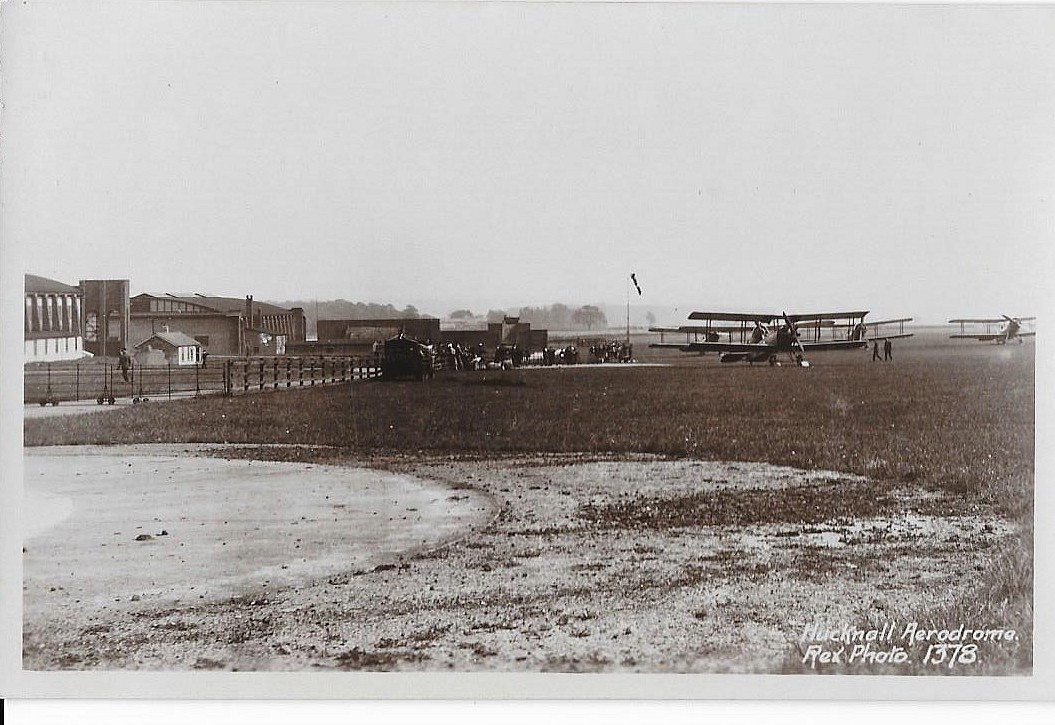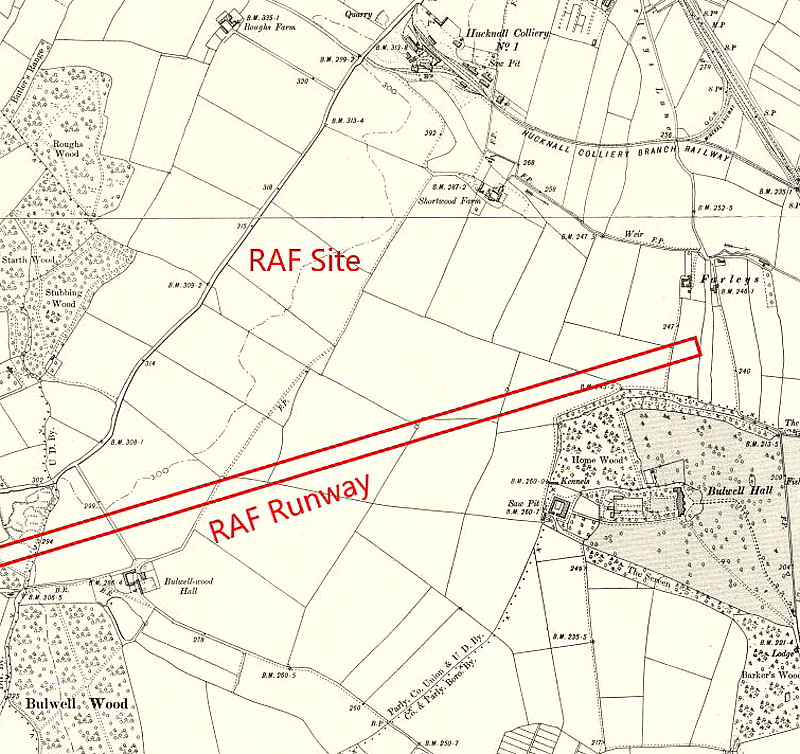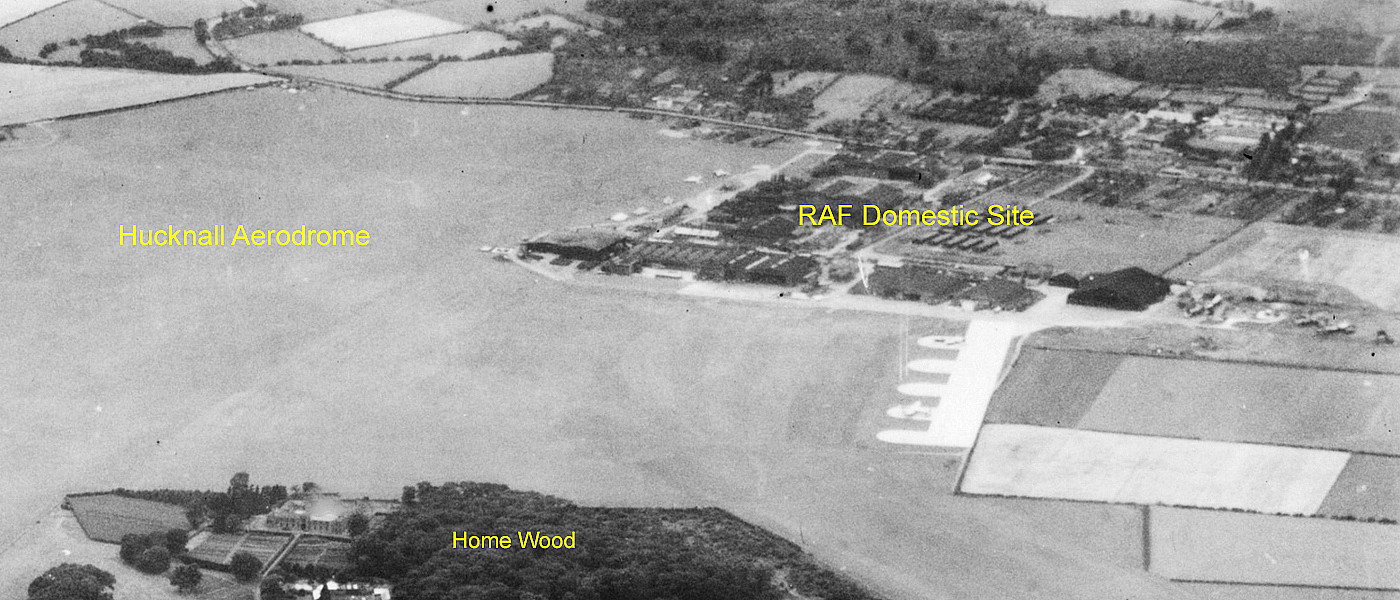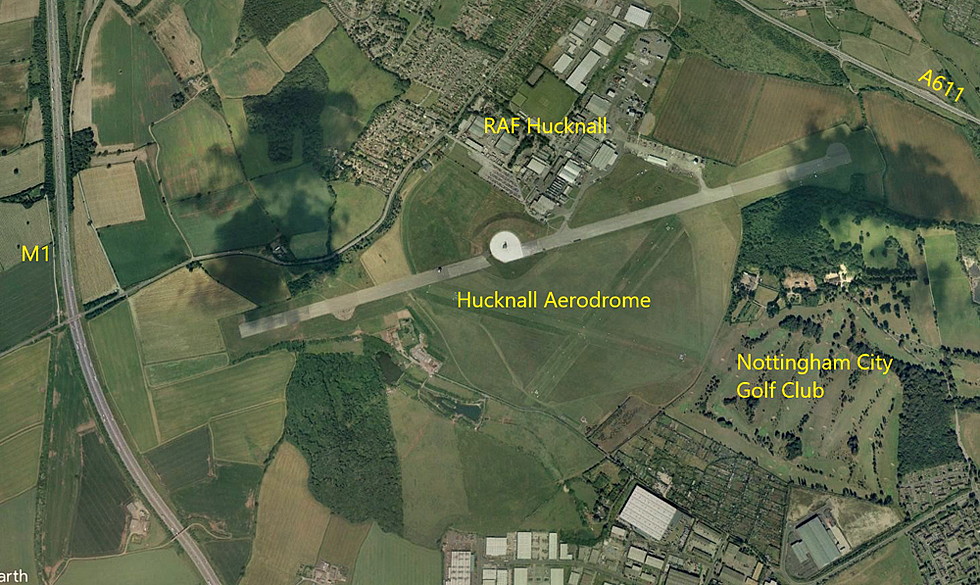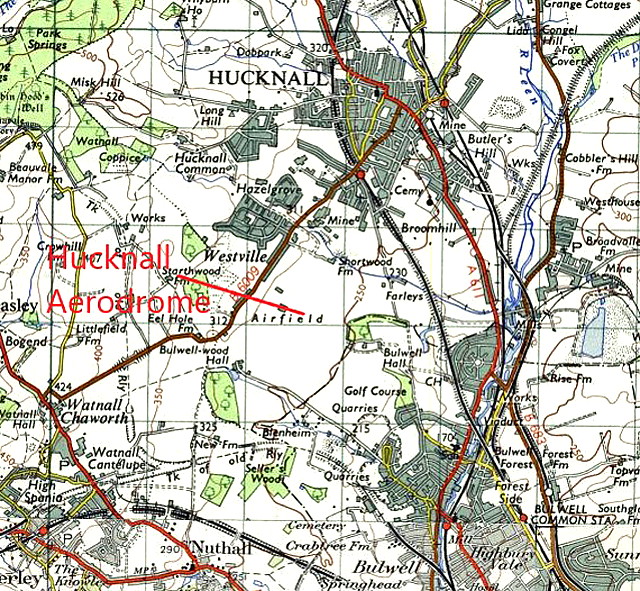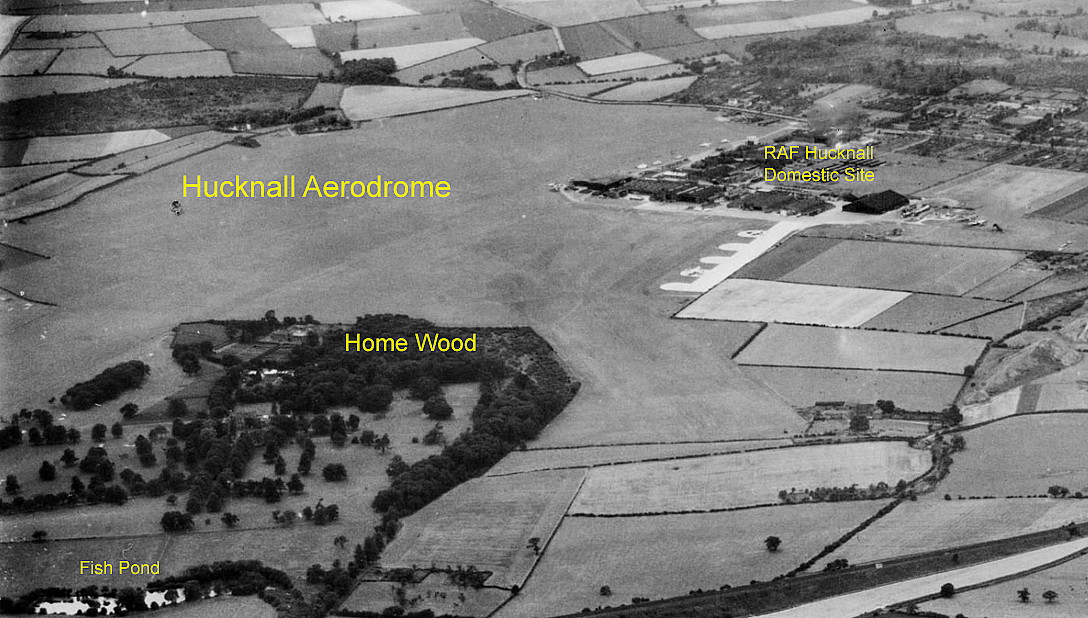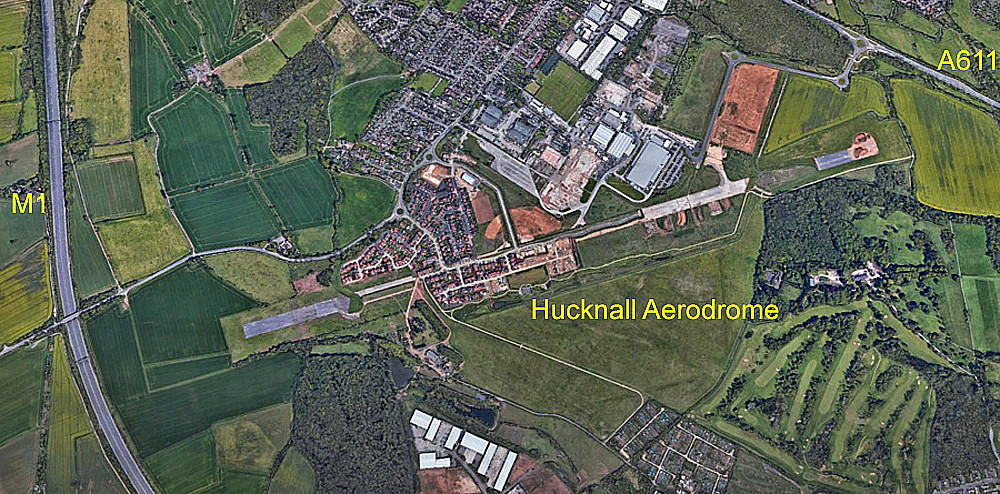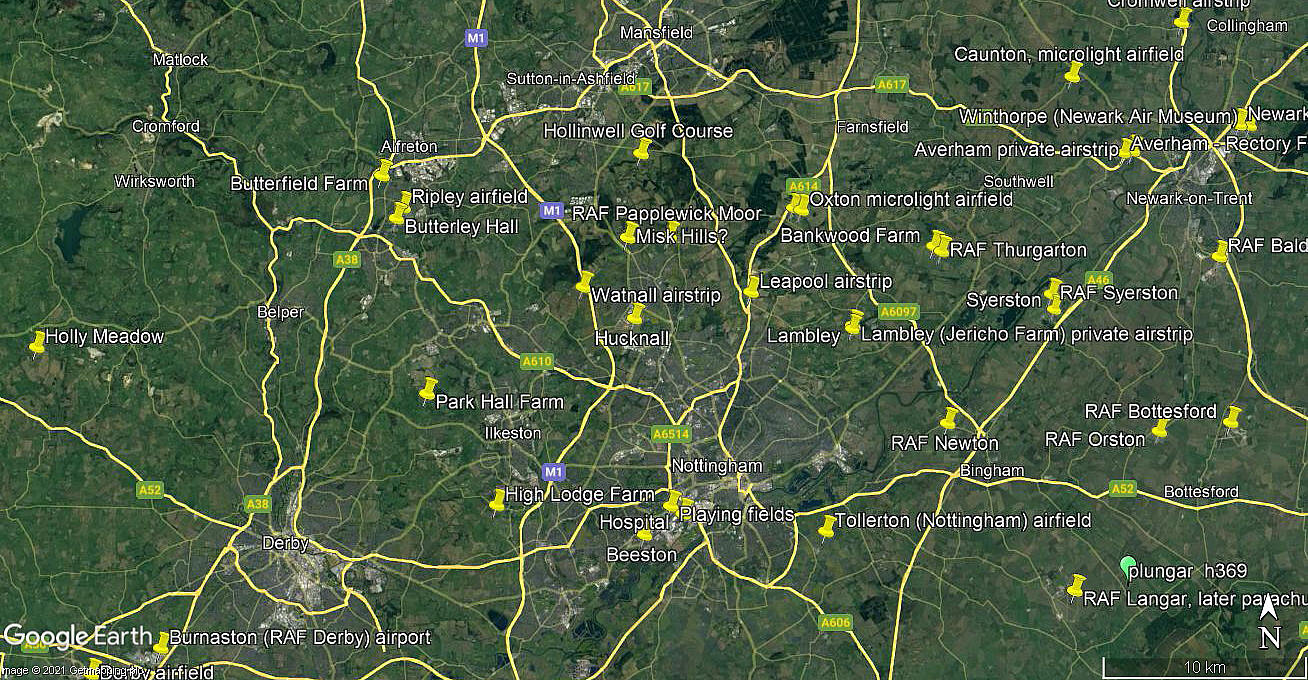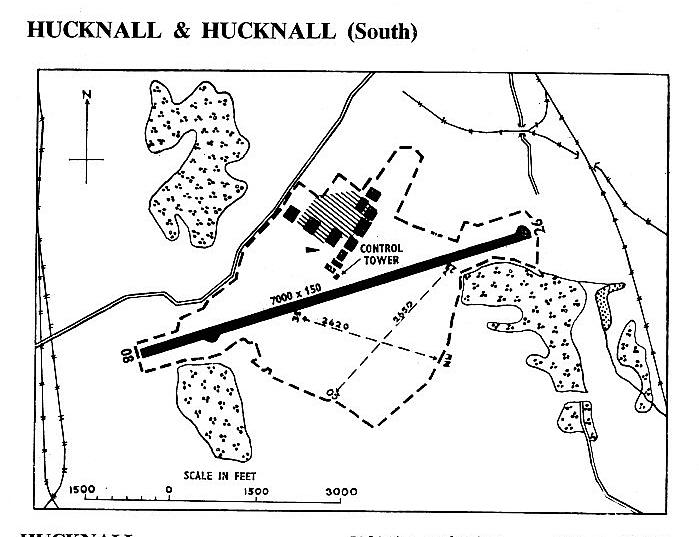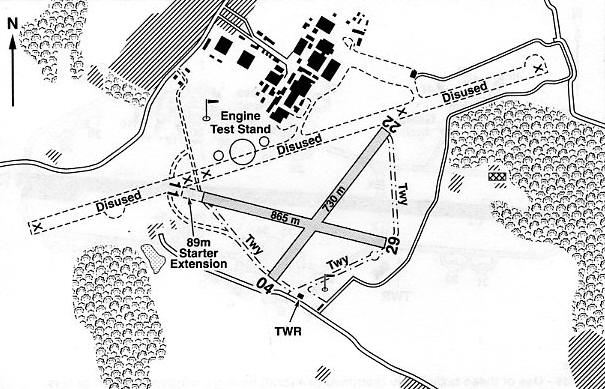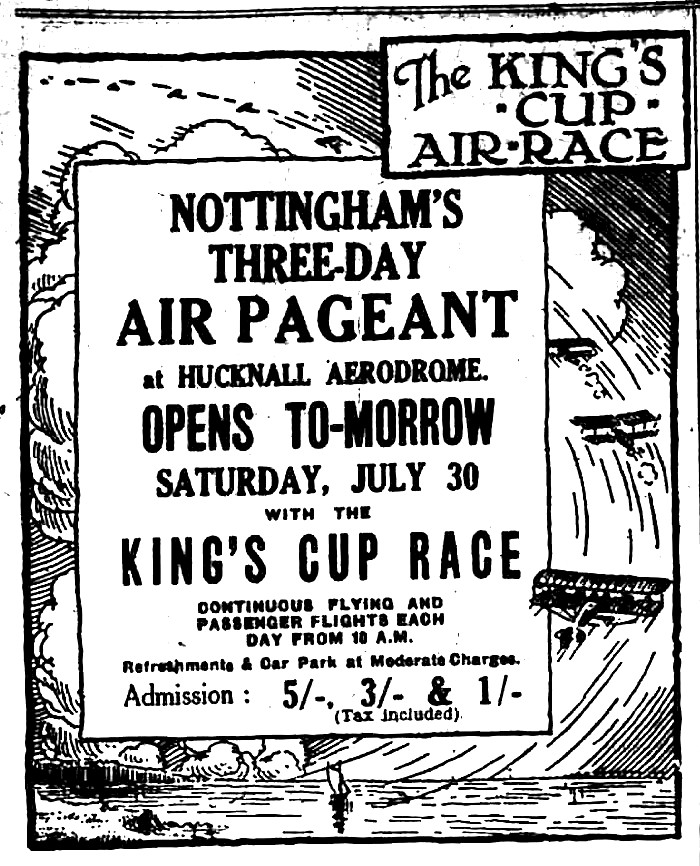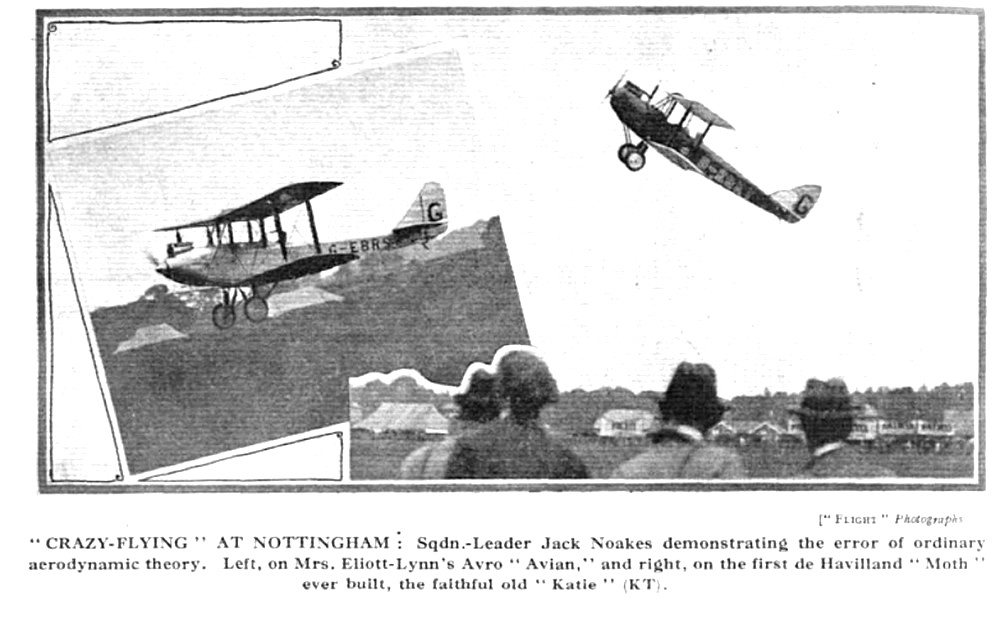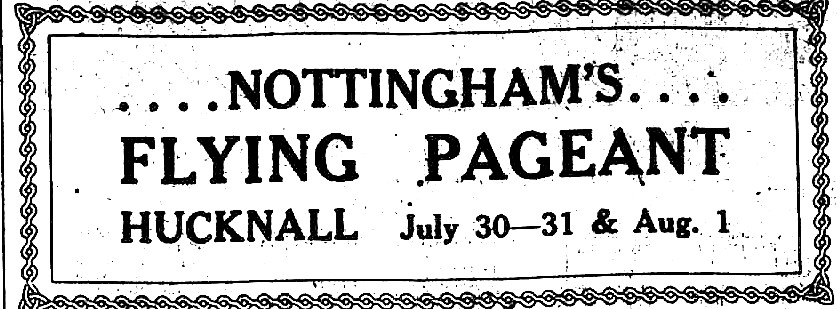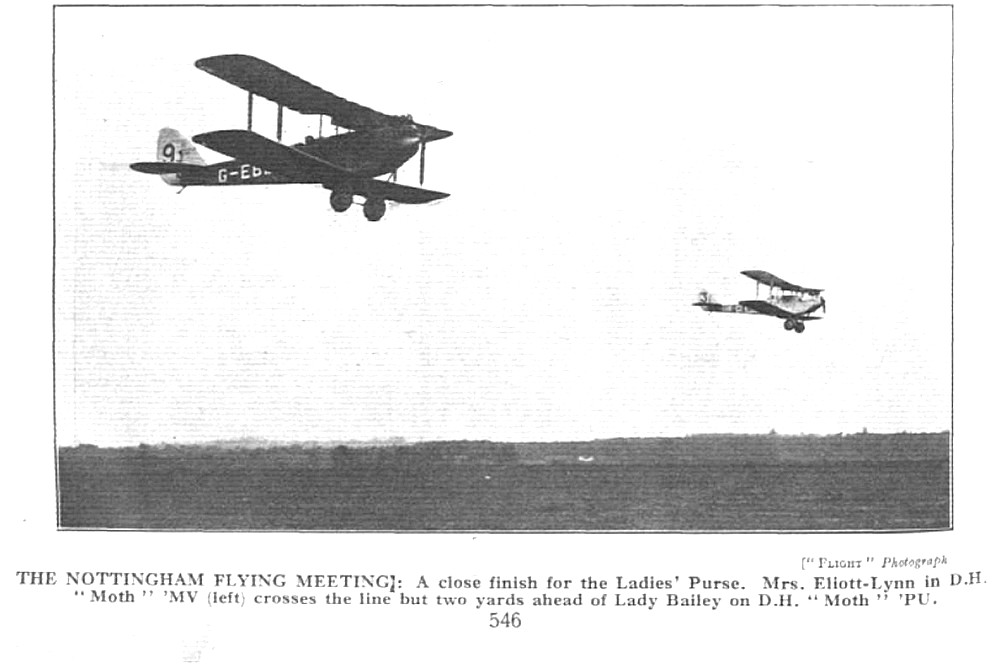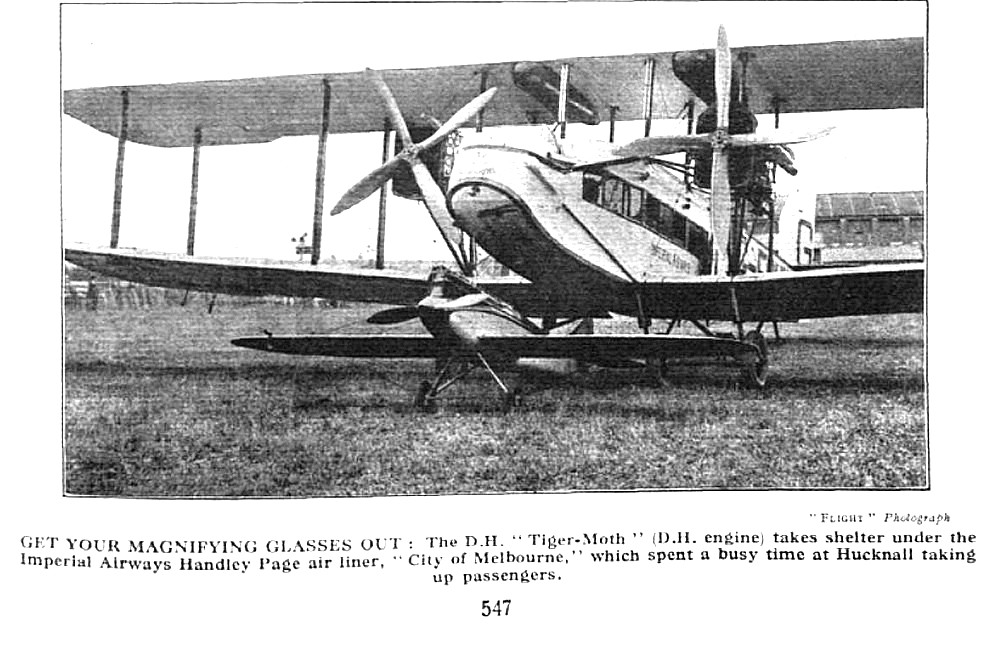Hucknall
HUCKNALL: Military aerodrome WW1, then civil, military again in WW2 and later reverting to civil aerodrome
Later, in the 1960s at least, known as HUCKNALL plus HUCKNALL SOUTH (The latter being the grass area)
Military users: WW1: RFC/RAF Training Squadron Station and Training Depot Station
117 Sqdn (Various types)
Note: This great picture from a postcard was kindly provided by Mike Charlton who has a fabulous collection. See: www.aviationpostcard.co.uk
Can anybody offer advice as to the probable date, and the types of aircraft?
A MICHAEL T HOLDER GALLERY
Note: I have added the area view from my Google Earth © database.
From 1928: RAF Bomber Command
98 Sqdn (Hawker Hinds then Fairey Battles)
WW2: RAF Flying Training Command 21 Group
25 (Polish) EFTS (Tiger Moths)
ATA (Air Transport Auxiliary)
Post 1945: RAF 664 AOP Squadron
Operated by: 1926 to 1928: Nottingham Aero Club
1965: Rolls-Royce Ltd
(HUCKNALL SOUTH operated by the Merlin Flying Club, which it appears was only used when flying from the hard runway had ceased)
1975: Rolls-Royce (1971) Ltd
1980s to 2000: Merlin Flying Club, Rolls Royce Ltd
Manufacturing: Rolls Royce Aero Engine factory
Air cargo: Post 1945: Alidair Cargo
Charter/air taxi: Post 1945: Aircruise
Flying school: Post 1945: Alidair, Merlin Flying Club
Location: SW of Broomhill, S & E of B6009, 5nm NNW of Nottingham
Period of operation: Military 1916 to 1919. Civil 1920s. Military from 1930s and WW2 to 1971? Then civil to present day. Closed in 2015
Site area: WW1: 135 acres 777 x 731
Note: These maps are reproduced with the kind permission of Pooleys Flight Equipment Ltd. Copyright Robery Pooley 2014.
Runways: WW2: ENE/WSW 1097 grass W/E 1097 grass
1956: Approx. 07/25 2200x46 hard
1965: 08/26 2134x46 hard NE/SW 808 grass NW/SE 798 grass
1990: 04/22 730x23 grass 11/29 676x25 grass
2000: 04/22 730x23 grass 11/29 865x25 grass
NOTES: It appears that after HUCKNALL closed in 1919, no flying took place until the Nottingham Aero Club reopened the site in 1926. I can imagine their feelings when the RAF decided they would take it back – in late 1927/early1928. The RAF resumed operations on the 26th March 1928.
THE KINGS CUP
Venue for the sixth King’s Cup Race on the 30th July 1927. It was decided to transfer it here from the originally planned venue at ENSBURY PARK in Bournemouth (DORSET), after a tragic mid-air collision took place there a few weeks before, during Air Races held at ENSBURY PARK involving the death of two ‘high profile’ pilots. Sixteen aircraft competed and the course that year was reduced to 540 miles, presumably making it a one-day event?
The winner was Mr W.L. Hope flying the de Havilland DH.60 Moth G-EBME with an average speed of 92.8mph. This was the only time the King’s Cup Race was held here.
A SECOND MICHAEL T HOLDER GALLERY
These items all relate to the three day Pageant held here from the 30th July to the 1st August 1927. The two adverts were published in the Nottingham Journal on the 29th July, and the pictures were published in Flight magazine on the 4th August.
Note: The second item was most interesting - my initial reaction being that this aircraft was most certainly not a Tiger Moth. And, it doesn't appear to have a registration applied. Further research revealed that it was indeed a Tiger Moth, a de Havilland DH71 registered G-EBQU, first flown in 1927 and retired in 1930. Only one example appears to have been built, and, flown here by Capt H S Broad, it was probably flown by him up from STAG LANE in NW London.
The third item is the Avro 594A Avian II, G-EBSD, being flown by Bert Hinkler and captioned as being a "Alpha Avian". The Austrailan Bert Hinkler died in the Tuscan Alps in Italy after he crashed, or crash landed on the 7th January 1933 flying a DH80A Puss Moth from HANWORTH AIR PARK to Australia in a record breaking attempt.
The fourth item shows the Duchess of Bedford getting ready to depart with her pilot Capt C D Barnard in a de Havilland DH60 Moth - possibly G-EBZI? This was hired or borrowed for the event, and she later acquired her own DH60G Moth Major, G-ACUR in 1934 which she learnt to fly in. She suffered terribly from tinnitus and her only relief was when flying. She disappeared in her Moth over the North Sea in 1937 and many suspect suicide.
This fifth item gives rise to questions. It shows Mrs Eliott-Lynn flying the Avro 594 Avian II, G-EBRS. Did she own it - or borrow it - or asked to fly it? In those days she was, generally, much better known as Lady Mary Heath. She is often referred to as Britains first woman pilot, but this is incorrect - she was the first woman holder of a commercial pilot license. Well worth looking up her history with a major flight to South Africa and holding an altitude record for a light aircraft of 16,000 ft in 1927.
The seventh picture shows the two most famous aviatrix of the day battling it out to the finish line for the 'Ladies' Purse' race. Both flying de Havilland DH60 Moths. Lady Mary Heath in the Moth G-EBMV, and Lady Bailey in the Moth, probably G-EBPU?
The eighth picture shows the DH71 Tiger Moth G-EBQU sitting beneath the Imperial Airways Handley Page W.10 airliner, G-EBMM, named City of Melbourne.
THE AIR TRANSPORT AUXILIARY
I had thought I had learnt quite a bit about the ATA (Air Transport Auxiliary) but the authors of ‘TOLLERTON- an airfield for Nottingham’ provided much more information: “When war was declared it was obvious to the major civilian airline companies, Imperial Airways and British Airways, that some curtailment of their services would take place and that this would create a surplus of pilots. The Air Ministry decided that these pilots would form the nucleas of a new organisation which would provide a variety of services, including the transport of dispatches and mail; transport of medical supplies and medical personnel; and the provision of an ambulance service. (At this stage the RAF still had its own plans with regard to the ferrying of aircraft.) This new body was to be known as the Air Transport Auxiliary.”
(My note: This came as quite a surprise. Until I was recommended to read this excellent book by a member of the British Airways historical section at the BA HQ near Heathrow, I was totally convinced the ATA was solely engaged in ferrying duties.)
“The original criteria for acceptance into the ATA were that a pilot needed to be male, between the ages of 28 and 50 years of age, and with a minimum of 250 hours flying experience. All pilots would be engaged on a civilian basis and the organisation was to run as a civilian operation. Originally 23 pilots signed contracts to work for the ATA, and they became the base from which the whole organisation grew.”
(My note: I expect you noticed that initial stipulation, “that a pilot needed to be male”, seems incredible today doesn’t it? And how bigoted considering the fame of women pilots of the thirties such as Amy Johnson, Emilia Earhart and Jean Batten etc.)
“In the spring of 1939 the RAF had introduced a scheme whereby pilots from operational squadrons collected new aircraft for their own units from their places of manufacture. Aircraft needed for the new RAFVR units were to be collected by pilots from one of two RAF ferry pools that had been set up specifically for this purpose. One of these pools was based at Hucknall in Nottinghamshire, the other was at Filton, near Bristol. Each of the two pools comprised sixteen pilots and six Avro Anson transport aircraft. The Ansons performed the role of taxis that took the ATA pilots and aircrew to and from the ferrying points.”
(My note: For the purposes of this 'Guide' I could leave it here as HUCKNALL has been mentioned - so move on. However, I do hope you will agree the rest of this ATA story is well worth telling and, having started at HUCKNALL, why not continue.)
A NEW ERA
“By the beginning of 1940 it had become apparent that the RAF simply did not possess the resources required to conduct ferrying operations on the necessary scale. Another reliable source of pilots was required to perform this vital duty, and the ATA was a logical place to look. Thus the Air Transport Auxiliary was designated as a Civil Ferry Pool and 41 Group RAF Maintenance Command took over responsibility for the overall running of the organisation.”
(My note: Still no women pilots, despite being at war and an assumed threat of invasion.)
“In the years immediately prior to the declaration of war the Government had set up two schemes for training civilians as the pilots who would be required in the event of war. These were the Royal Air Force Voluntary Reserve (RAFVR) and the Civil Air Guard (CAG). Pilots in the RAFVR were destined to serve in the RAF but those pilots who had trained in the CAG could possibly be used in the ATA. A major problem, however, was that most of the ATA pilots had learnt to fly in small, single-engine types like the de Havilland Tiger Moth. The aircraft they would be required to fly were larger, technologically more advanced, and usually much more powerful.”
(My note: As a private pilot and having flown, or rather interfered with the controls of over sixty different types of aircraft, it would scare me witless to even start the engine of a Hurricane or Spitfire, let alone try to taxy it – the idea of flying it is out of the question. I was trained to fly different types with an instructor and can vividly remember being let loose on a single-seater three-axis microlight type for the first time - and having to suppress my anxiety. This said I was then in my early fifites so knew a thing or two about potential risk. When much younger you don't usually consider risk - it's all about the challenge and the adventure.
In those days there were no dual control versions of the Gladiator, Hurricane, Spitfire etc. I therefore most sincerely applaud the sheer guts and determination of the RAF and ATA pilots facing this challenge.
I am told by reading up on the subject, that few had any reservations, they were totally determined and really wanted to fly these types. The very idea of getting thoroughly ‘checked-out’ didn’t enter into their minds. Not least I suppose because it wasn’t an option anyway! Some might argue that flying a Harvard under dual instruction was quite enough, it was certainly considered to be so in those days. And of course these ‘classic’ aircraft were ‘ten a penny’ in those days and not almost priceless artefacts.)
TRAINING
“To address this problem it was decided that suitable candidates should be sent to the RAF Central Flying School, (My note: That would be CRANWELL?), for further training and assessment. There they would learn to fly in the Harvard trainer and, if successful in that, go on to fly Battles, Blenhaims, Hurricanes and Spitfires – or, for that matter, anything else that was available.”
(My note: The joke today amongst those that should know, is that after ten hours solo in a Spitfire, you might be ready to fly a Harvard!)
“ATA pilots would be required to ferry whichever aircraft the operational squadrons required, encompassing a range of types and variants. The aircraft that a pilot could fly on ferry duties with the ATA were split into six categories and each pilot was classified according to type of aircraft that he or she was qualified to fly.”
The authors of ‘TOLLERTON’ provide a table and I think it makes for very interesting reading as by todays standards these broad classifications would be unthinkable. For example the very idea that the Tiger Moth and Gladiator could even be considered in the same category beggars our imagination today.
Category Type Aircraft
Class 1 Light, Single Engine: Magister, Tiger Moth, Proctor, Hart, Gladiator and Swordfish
Class 2 Advanced, Single Engine: Spitfire, Hurricane, Mustang, Lysander, Hellcat, Typhoon, Tempest, Corsair
Class 3 Light, Twin Engine: Oxford, Dominie, Anson
Class 4 Advanced, Twin Engine: Hudson, Wellington, Blenheim, Beaufighter, Mosquito, Dakota, Mitchell
Class 5 Four Engine: Stirling, Halifax, Lancaster, Flying Fortress, Liberator
Class 6 Sea-Planes: Catalina, Sunderland
This is a very complicated subject. I am absolutely certain nobody in the ATA would have been let loose on a Lancaster without type training, having just flown Stirlings before? This said, for example, when the first Dakotas arrived the US authorities provided no pilots notes, so the first RAF aircrews to fly them had to air test them from scratch and provide their own pilots notes as to how to fly them. Did this also apply to other US types provided under Lend/Lease?
The authors of ‘TOLLERTON’ make a very important point, dispelling quite a commom myth: “All aircraft in classes 1, 2 and 3 could be flown solo. However in the remaining categories some assistance might be required according to the type of aircraft being flown.
Thus, some aircraft would require any or all of the following: co-pilot, flight engineer, and pilots assistant (usually an Air Training Corps member or a Sea Cadet). All the four-engine aircraft required at least a flight engineer to accompany the pilot to assist in the flying of the machine. However, there was no bar to women flying any of the aircraft provided that they had passed their training course on the respective type.”
(My note: Mention is made elsewhere in this Guide of young teenage Air Cadets performing quite astonishing duties for long ferry flights and then having to make their own way home by train over hundreds of miles and thinking nothing of it. It was expected of them.)
Probably the most important point is to dispel this myth: “Mention is made …..of how amazed people were to see the sight of a heavy bomber being flown….by a single pilot with no other aircrew. Such accounts of pretty young slips of girls bringing in mighty Halifaxes or Lancasters entirely on their own appear to have been widespread at the time, but they were simply not true. In fact it was physically impossible to perform from the pilot’s seat all the flight duties necessary to take-off, fly, and land such aircraft safely. Nevertheless the tale had endearing qualities and has certainly became an enduring myth.”
I think this myth came about when, after landing and seeing a young lady emerge, it was probably asked where the pilot was? To which she could quite correctly answer; "I am the pilot".
What was true, today even more astonishing to learn (?) was that suitably qualified ATA pilots could be expected, in one day, to fly anything from a Tiger Moth to a Lancaster and that I would say is their enduring legacy. They were, without much doubt in sheer piloting skills, amongst the very best.
AN INTERESTING STATISTIC
Another interesting fact is that the proportion of accidents between male and female pilots in the ATA was virtually exactly the same! “During the war 150 aircrew with the ATA lost their lives ferrying aircraft of whom 14 were women.” And, don’t forget, ATA pilots had to do their own navigation and did undertake a RAF navigation course.
For some reason the RAF could not find many competent navigators or so it is claimed. The probable reason for this now seems simple enough to explain. Quite frankly the methodology used was barmy in the extreme, certainly for Bomber Command in the early stages of WW2. In most cases, for example, it was not considered desirable for a navigator to be able to look out of the aircraft and compare what they could see with a chart.
One reason was that mathematical geniuses had been employed, and they of course had no idea at all about how aircraft can be navigated. Quite frankly a mob of fools, but that is being unkind.
A LEGACY
For example when learning to fly, (in the late 1980s), I still had to master the ‘Dalton’ spinwheel method. It was, without doubt a most amazing device, and gave quite accurate results if every known factor was put into the calculation. But of course the UK weather is by nature highly volatile and subject to continuous changes. This said I pretty quickly realised that it didn’t really serve much purpose for VFR flights, IF you can read a map. And for flights in IMC I suspect it was virtually useless compared to the RNAV equipment then available.
SOME MORE FACTS AND FIGURES
Getting back to the ATA these statistics must be on record: “As the war progressed so the ATA grew in size to meet the ever increasing demands placed on it. By the end of 1943 it had made over 100,000 journeys ferrying aircraft for the RAF and the Royal Navy. The final figure for the whole of the war was in excess of 300,000 ferry jouneys, a truly staggering amount. The highest number of deliveries in a single day occurred on 21 February 1945 when no less than 570 aircraft were moved. These remarkable figures were achieved with a workforce that never exceeded 700 pilots at any one time. Indeed, during the whole duration of the war just over 1,300 pilots were employed by the ATA, of whom 166 were women.”
Bloody hell, here we go again, propaganda getting the upper hand. Until doing this research I felt fairly certain the majority of ATA pilots were women and to give them credit they have certainly made a good case for their valuable contribution. Except that by and large the slightly less than 90% of ATA male pilots have now been both pretty much ignored and forgotten. And, that can’t be right or justified either?
MAKING A POINT
The authors of ‘TOLLERTON’ make these points: As said before; “During the war over 150 aircrew with the ATA lost their lives ferrying aircraft, of whom 14 were women.” (My note: This proves the competence of the female pilots was exactly on par with their male colleagues). “Overall though, this accident rate was very low. This was a remarkable achievement, the more so when the range of aircraft flown, the conditions they were flown in, and the airfields that were used are taken into account.”
(My note: Quite so, and don’t forget that attempts to camouflage airfields not only hindered those returning from ‘Ops’, they also hindered the ATA pilots).
“ATA pilots had to work very hard: they were required to work for thirteen days at a time followed by two rest days off. During the summer their working day could last from dawn to dusk, as they were expected to make as many deliveries as they could during the hours of daylight. During the shorter daylight hours in winter they were expected to fly as long as the light and weather conditions permitted. Some of the pilots employed were even physically handicapped. There was an instance of a pilot having only one arm, his right arm having been amputated at the shoulder. This meant that there were certain aircraft that it was physically impossible for him to fly, but there were others he could ferry, and did.”
(My note: Quite incredible, can you imagine trying to fly even a Tiger Moth or Magister with just one arm today?)
ANOTHER ASPECT
Another story they tell makes for interesting reading and amply illustrates how those who attain high levels of power invariably lose any common sense, and virtually all knowledge obtained when flying, they once possessed. Goering was a prime example on the German side and ‘Butcher’ Harris (not ‘Bomber’ Harris’) as he was known by most of his aircrews, was a prime example on our side. It really is very odd that such people should become, in a very elementary way, utterly stupid in many respects. Probably one answer is that no individual human being can absorb the sheer complexities of the task confronting them?
Some say that Arthur Harris was ‘a pilot’s pilot’ but it is obvious that somewhere along the line in WW2 he ‘lost the plot’ entirely in this respect. One can only imagine the effect on morale for the bombers crews at that time, knowing that their most senior officer didn’t have a clue about the realities they confronted – hence the term they adopted, ‘Butcher Harris’. What brings me to the verge of tears is that despite this realisation, those young men continued to climb into their bombers knowing full well their chances of survival, even on a single raid, were next to nil. Only chance, or fate, could save them. A few crews had the self-determination and experience to reduce the odds, but most followed orders.
As mentioned earlier, here is the example to prove how ‘out of contact’ with reality Harris was in 1943. “At times adverse weather conditions would make all flying impossible. There is an amusing anecdote about Sir Arthur ‘Bomber’ Harris – a man well known for not suffering fools gladly – when he was Commander-in-Chief Bomber Command. In January 1943 the winter weather had been atrocious: no flying for had been possible for a fortnight and no aircraft had been delivered to the waiting operational squadrons. ‘Bomber’ Harris was less than impressed and made his displeasure known. An ATA emissary was dispatched to Harris to resolve the problem. Harris began by demanding how he was expected to get on with the war if the wretched ATA failed to deliver the aircraft that he needed. When asked by the emissary how many raids Bomber Command had carried out in the previous fortnight, the reply was, ‘None, how do you expect us to carry out raids in this appalling weather?’
The ATA officer pointed out that the weather was the same for the ATA pilots. If as Harris had insisted, he said, then if the ATA would try to deliver to deliver the aircraft, but it was likely they would crash and Harris would not get his aircraft anyway. Faced with such logic, Harris apologised and invited the officer to dine with him that evening.”
(My note: Full marks to Harris for owning up on this occasion, but even so, very unsettling that Harris had ignored the very basics of these flying conditions in the first place?) Unflyable weather still occurs today, and always will of course, and I am invariably astonished by most passenger reactions. On the whole intent and happy on chancing arriving very early in ‘the next world’ rather than sticking around for a few hours in the terminal in this one.
MORE HUCKNALL STATS
In late 1944, 1764 RAF personnel plus 228 WAAFs were stationed here
GA INFO
In 1977 several GA types were based here, (quite unusual in those days I suppose for what was essentially a private company owned airfield?). These include: Auster J/4 G-AIJT of the Merlin Flying Club, DH.82A Tiger Moth G-AOEG of the Midland Tiger Flying Group, the Tipsy Nipper 2 G-ARXN of the Griffon Flying Group, Beagle A.61 Terrier 2 G-ATBU and the Piper PA-28 Cherokee 140 G-ATEZ.
In addition were the Jodel D.140B Mousquetaire G-ATSU, Gardan GY-80 Minicab G-AVRW, Jodel D.117A G-AXHV, Cessna 310Q G-BBNS of Birchwood Boat International Ltd, the Taylor JT.1 Monopolane G-BDAD, (airworthy?), and Evans VP.1 G-BEHJ. By jove…what a spiffing good mix here to play with!
A LATER DISCOVERY
We have Mr Graham Frost, a great friend of this 'Guide', to thank for discovering that a Heinkel He.70 Blitz, G-ADZF, (ex D-UBOF), was based here. And, registered to Rolls-Royce - from 18.12.35 until 06.11.54 - although listed as being scrapped in 1944. It was a fast, sleek, low-wing monoplane for up to six passengers, powered by a single 575hp BMW engine. So, did Rolls-Royce use it as a company VIP transport? It appears Lufthansa used them as passenger planes for a while, but due to it having a cramped cabin, it was later used for mail deliveries.
MORE RECENT NEWS
In November 2023 I was kindly contacted by Jono Martin, who as a lad lived near MORETON VALANCE in Gloucestershire where Meteors were being test flown and prepared for RAF service. It now appears that when the Meteor F.3 was introduced, one F.1 example, EE227, was ferried up here to Rolls-Royce. They been developing the RB.50 turbo-prop 'Trent' engine since 1944 and when EE227 was delivered in February 1945 two 'Trent' engines were fitted. What is also notable, to me at least, not having a clue about this Meteor, is that to maintain ground clearance five-bladed propellers were fitted.
One great aspect of producing this 'Guide' is that nigh on every day I learn something new. (But at least the last twenty plus years of research have given me a few clues). For example I had always thought the 'Dart' was the first Rolls-Royce turbo-prop. In fact the RB.53 'Dart' was first run in 1946. Nice to see that Rolls-Royce believe in re-cycling, the 'Trent' name reappearing around 1990 for the RB.211.
Paul L. Shank
This comment was written on: 2017-07-02 14:13:05Enjoyed reading your brief history of the ATA and particularly the piece on Bomber Harris. I especially enjoyed your weaving your personal observations/experiences into the history. Regards, from your Allies back in the U.S. Paul
Reply from Dick Flute:
Hi Paul, Many thanks indeed. I shall keep your comment posted, not least because I believe that this is the first time I have actually heard from somebody in the USA. This said, I have noticed that this web-site does have many visitors from the USA - and feed-back is always welcome - especially if it is positive. Which, I am pleased to say, the vast majority is. My best regards, Dick
We'd love to hear from you, so please scroll down to leave a comment!
Leave a comment ...
Copyright (c) UK Airfield Guide















